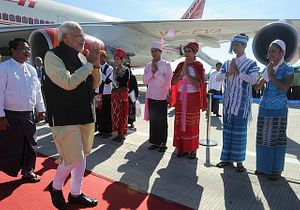India’s Prime Minister Narendra Modi used the latest ASEAN summit in Myanmar’s capital Naypyidaw this week to unveil India’s new “Act East Policy,” and convince his Southeast Asian counterparts that his government is serious about boosting ties with the region.
“A new era of economic development, industrialization and trade has begun in India. Externally, India’s ‘Look East Policy’ has become ‘Act East Policy,’” Modi told the ASEAN-India Summit on November 12. He reiterated this point in his address at the East Asia Summit on November 13, stressing his government’s attention to the region in the six months since he came to power.
Modi’s remarks are a deliberate attempt to signal a more action-oriented policy towards ASEAN specifically and East Asia more generally, in contrast to India’s original Look East Policy first formulated under Prime Minister Narasimha Rao in the 1990s. The term “Act East“ was first popularized by U.S. Secretary of State Hillary Clinton in a speech during her visit to India in July 2011, where she encouraged New Delhi “not just to look East, but to engage East and act East.”
In his remarks to Southeast Asian leaders at his first ever ASEAN-India Summit, Modi highlighted specific recommendations to advance ASEAN-India economic relations over the next few years, including establishing a special purpose vehicle for project financing, building information highways, and inviting ASEAN countries to participate in India’s ongoing economic transformation. Modi also touched on the South China Sea in both the ASEAN-India Summit and the East Asia Summit, reiterating the importance for all actors in “following international law and norms on maritime issues.”
Separately, Modi held productive meetings with individual Southeast Asian states, including Singapore – currently New Delhi’s strongest partner in the region – and Myanmar, which is the only ASEAN country India shares a land border with. Modi and Burmese President Thein Sein both reviewed key ongoing joint infrastructure projects such as the India-Myanmar-Thailand trilateral highway and the Kaladan transport project; while Singapore Prime Minister Lee Hsein Loong invited Modi to visit Singapore in 2015 to commemorate the 50th anniversary of India-Singapore bilateral ties.
He also met Myanmar democracy icon Aung San Suu Kyi, who previously studied in India and whose mother was a former ambassador to India. After the meeting, Indian foreign ministry spokesman Syed Akbaruddin tweeted that Suu Kyi told Modi she considered India “her second home.”
Thus far, Modi’s message has been well received in Southeast Asia and at home. Thail Prime Minister Prayut Chan-o-cha lauded Modi’s “Make in India” initiative, saying it was also a potential model for his country. Shivraj Singh Chouhan, the chief minister of the central Indian state of Madhya Pradesh, said on his Twitter account that Modi’s message linking ASEAN-India ties to New Delhi’s own economic reforms “shall herald a new era for India.”
Symbolically, Modi has also been making waves with his use of online media. In addition to actively tweeting about his meetings, Modi made his first post on the photo-sharing website Instagram an image of the empty stage inside the Myanmar International Convention Center where the ASEAN Summit was being held. The ASEAN Secretariat subsequently included it in its list of “significant firsts” at the 25th ASEAN Summit on its Facebook page.
Despite this glowing reception, some in India are already cautioning that Modi must quickly demonstrate that India’s “Act East” policy can produce tangible results to boost ties with ASEAN. Indian expert C Raja Mohan, now a distinguished fellow at the Observer Research Foundation, argued in The Indian Express that Modi needs to deliver results on trade, given that New Delhi has been dragging its feet on the ASEAN-led Regional Comprehensive Economic Partnership (RCEP), expected to be concluded by 2015. V.S. Seshadri, India’s former ambassador to Myanmar, wrote in The Hindu on November 13 that India and Myanmar should immediately set up a high-level bilateral mechanism to review progress on infrastructure projects and broaden the discussion to include “soft infrastructure,” including transit and transport agreements.
Following his meetings in Naypyidaw, Modi continued his 10-day, three-nation trip abroad by attending the G-20 meeting in Brisbane, Australia on November 15 and 16. After additional time in Australia, he will then move to his final stop in Fiji on November 19, making the first visit there by an Indian prime minister in more than three decades.

































